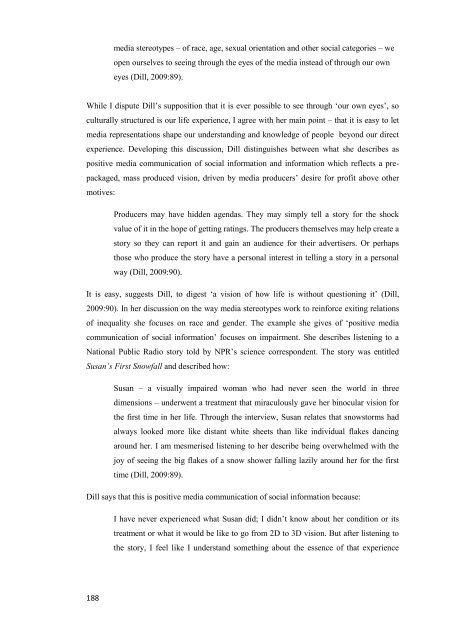A thesis submitted in partial fulfilment of - Etheses - Queen Margaret ...
A thesis submitted in partial fulfilment of - Etheses - Queen Margaret ...
A thesis submitted in partial fulfilment of - Etheses - Queen Margaret ...
Create successful ePaper yourself
Turn your PDF publications into a flip-book with our unique Google optimized e-Paper software.
188<br />
media stereotypes – <strong>of</strong> race, age, sexual orientation and other social categories – we<br />
open ourselves to see<strong>in</strong>g through the eyes <strong>of</strong> the media <strong>in</strong>stead <strong>of</strong> through our own<br />
eyes (Dill, 2009:89).<br />
While I dispute Dill‟s supposition that it is ever possible to see through „our own eyes‟, so<br />
culturally structured is our life experience, I agree with her ma<strong>in</strong> po<strong>in</strong>t – that it is easy to let<br />
media representations shape our understand<strong>in</strong>g and knowledge <strong>of</strong> people beyond our direct<br />
experience. Develop<strong>in</strong>g this discussion, Dill dist<strong>in</strong>guishes between what she describes as<br />
positive media communication <strong>of</strong> social <strong>in</strong>formation and <strong>in</strong>formation which reflects a pre-<br />
packaged, mass produced vision, driven by media producers‟ desire for pr<strong>of</strong>it above other<br />
motives:<br />
Producers may have hidden agendas. They may simply tell a story for the shock<br />
value <strong>of</strong> it <strong>in</strong> the hope <strong>of</strong> gett<strong>in</strong>g rat<strong>in</strong>gs. The producers themselves may help create a<br />
story so they can report it and ga<strong>in</strong> an audience for their advertisers. Or perhaps<br />
those who produce the story have a personal <strong>in</strong>terest <strong>in</strong> tell<strong>in</strong>g a story <strong>in</strong> a personal<br />
way (Dill, 2009:90).<br />
It is easy, suggests Dill, to digest „a vision <strong>of</strong> how life is without question<strong>in</strong>g it‟ (Dill,<br />
2009:90). In her discussion on the way media stereotypes work to re<strong>in</strong>force exit<strong>in</strong>g relations<br />
<strong>of</strong> <strong>in</strong>equality she focuses on race and gender. The example she gives <strong>of</strong> „positive media<br />
communication <strong>of</strong> social <strong>in</strong>formation‟ focuses on impairment. She describes listen<strong>in</strong>g to a<br />
National Public Radio story told by NPR‟s science correspondent. The story was entitled<br />
Susan‟s First Snowfall and described how:<br />
Susan – a visually impaired woman who had never seen the world <strong>in</strong> three<br />
dimensions – underwent a treatment that miraculously gave her b<strong>in</strong>ocular vision for<br />
the first time <strong>in</strong> her life. Through the <strong>in</strong>terview, Susan relates that snowstorms had<br />
always looked more like distant white sheets than like <strong>in</strong>dividual flakes danc<strong>in</strong>g<br />
around her. I am mesmerised listen<strong>in</strong>g to her describe be<strong>in</strong>g overwhelmed with the<br />
joy <strong>of</strong> see<strong>in</strong>g the big flakes <strong>of</strong> a snow shower fall<strong>in</strong>g lazily around her for the first<br />
time (Dill, 2009:89).<br />
Dill says that this is positive media communication <strong>of</strong> social <strong>in</strong>formation because:<br />
I have never experienced what Susan did; I didn‟t know about her condition or its<br />
treatment or what it would be like to go from 2D to 3D vision. But after listen<strong>in</strong>g to<br />
the story, I feel like I understand someth<strong>in</strong>g about the essence <strong>of</strong> that experience




